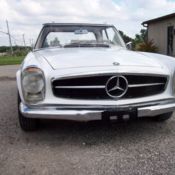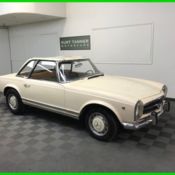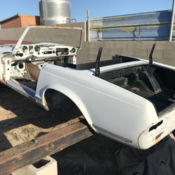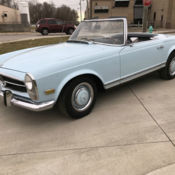Description
1967 Mercedes SL250 4 spd. manual shift European model. Stunning color combination. Mechanically sound and well maintained, eady for a cross country journey as any old car can be. We encourage and welcome any type of inspection. History of the SL is known since 1987. It has been in the same family since then as well. Tight shut lines, ven panel gaps, nd trunk, ood, nd doors shut properly. Cannot find any rust or rot on this SL, lease scroll down the page for pictures. Convertible top that is not pictured is in very good shape and is only a few years old. Please note I have been on eBay for well over a decade and have sold several cars with 100% positive feedback. There are more pictures at jim hailey classic cars with a dot and as always a com. You can call me if you prefer at (214) 415-7373. A Wealth of Pagoda information is available here... http://www.sl113.org/wiki/ The 250 SL was introduced at the 1967 Geneva Motor Show.[10] Production had already commenced in December 1966 and ended in January 1968. The short one-year production run makes the 250 SL the rarest of the W 113 series cars. The 250 SL retained the stiffer suspension and sportier feel of the early SLs, ut provided improved agility with a new engine and rear disc brakes. Range also improved with increased fuel tank capacity from 65 L (17.2 US gal) to 82 L (21.7 US gal). Like its predecessor, he 250 SL was offered with a 4-speed automatic transmission, nd 4-speed or ZF 5-speed manual transmissions.[10] For the first time, n optional limited slip differential was also available. Of the 5,196 250 SLs produced, ore than a third were sold in the US. The main change was the use of the 2,496 cc (2.5 L) M129.II engine with 6 mm (0.2 in) increased stroke, mm (0.1 in) increased valve ports, nd seven main bearings instead of four. The nominal maximum power remained unchanged at 150 PS (110 kW; 150 hp), ut torque improved from 145 lb·ft (197 N·m) to 159 lb·ft (216 N·m).[10] Resiliency also improved with a new cooling water tank ("round top") with increased capacity from 10.8 L (2.9 US gal) to 12.9 L (3.4 US gal), nd a standard oil-water heat exchanger. The wider power band of the 250 SL resulted in noticeably improved performance, s the 230 SL engines rarely produced more than 143 PS (105 kW; 141 hp) in practice.[7]



